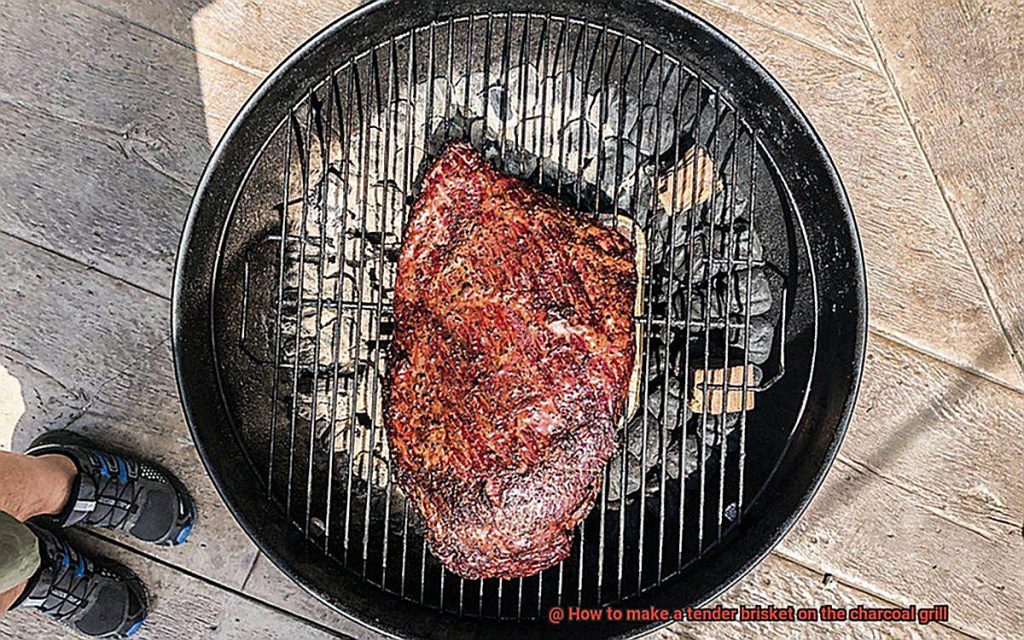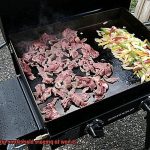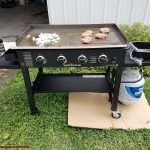Imagine yourself at a laid-back backyard cookout with your loved ones, where the tantalizing aroma of a perfectly cooked brisket is wafting through the air. The meat is so tender that it melts in your mouth, leaving behind an explosion of flavors that will have you craving for more. But how can you replicate this culinary masterpiece on the charcoal grill? Fear not, my fellow meat lovers. I am here to share all the tips and tricks you need to make a tender brisket on the charcoal grill.
First things first – quality meat is key. When it comes to brisket, marbling is everything. Fat equals flavor, so choose wisely. Secondly, take some time to prep your grill properly by creating two heat zones for even cooking. Remember, patience is a virtue when it comes to achieving tenderness through low and slow cooking.
Once your grill is ready and your brisket has been seasoned to perfection, sit back and relax while the grill works its magic. But don’t get too comfortable just yet – I’ve got all the monitoring tips you need to ensure that you don’t overcook or undercook your prized meat. And just when you think you’ve reached the pinnacle of brisket greatness, I’ll reveal some finishing touches that will elevate your game.
So grab a cold one and let’s fire up the grill for an epic culinary adventure that will leave your taste buds dancing with joy and make you the star of every backyard barbecue party. Let’s make some tender brisket on the charcoal grill.
Contents
The Importance of Quality Meat
When it comes to making a tender brisket on the charcoal grill, quality meat is essential. A high-quality brisket will not only be more delicious but also easier to cook. Here are some crucial factors to consider when sourcing quality meat for your brisket.
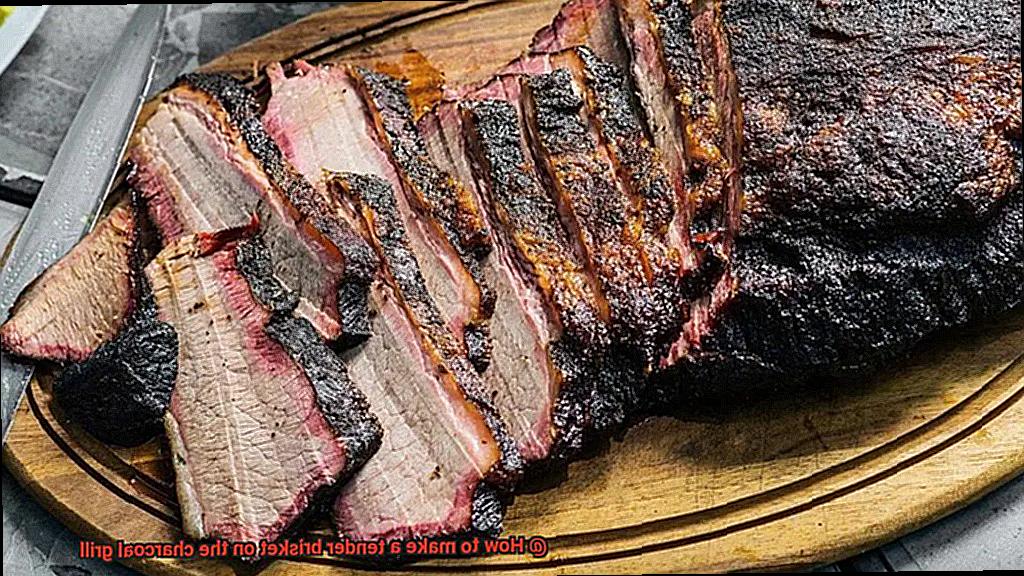
Firstly, always source your meat from a reputable butcher or meat supplier. A trustworthy supplier ensures that the meat is fresh, well-aged, and has been handled with care. Secondly, look for good marbling in the brisket. Marbling refers to the streaks of fat running through the meat. The more marbling a brisket has, the more flavor and moisture it will provide during cooking, resulting in a tender and juicy final product.
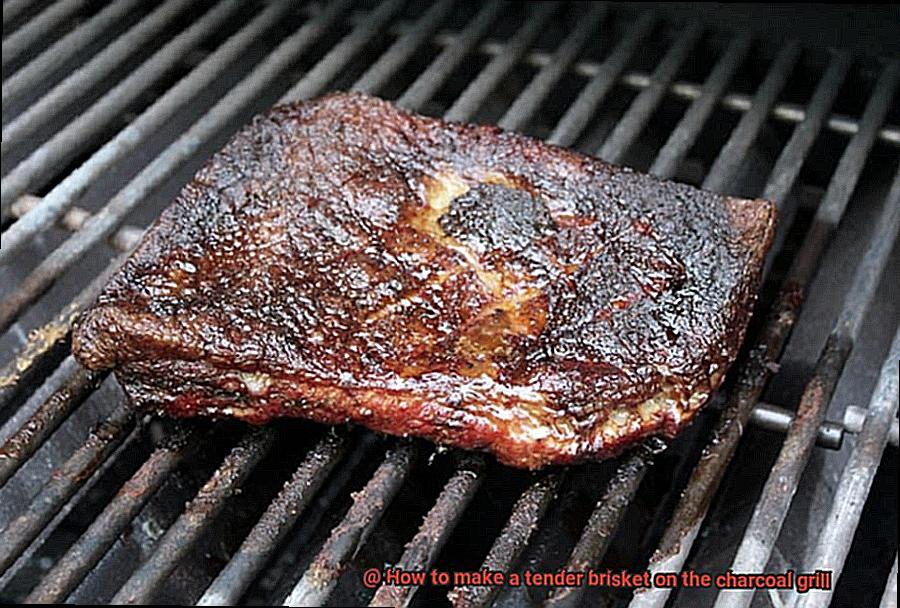
Thirdly, choose the right type of beef for your brisket. Most briskets come from either Angus or Wagyu cattle. Angus beef is known for its marbling and rich flavor, while Wagyu beef is prized for its high levels of intramuscular fat. Both types of beef can produce excellent briskets, but Wagyu beef tends to be more expensive due to its rarity and high demand.
Lastly, consider sustainability and ethics when choosing your meat. Look for beef that has been raised without antibiotics or hormones and has been given access to pasture. This not only ensures that the animal was treated humanely but also results in better-tasting meat.
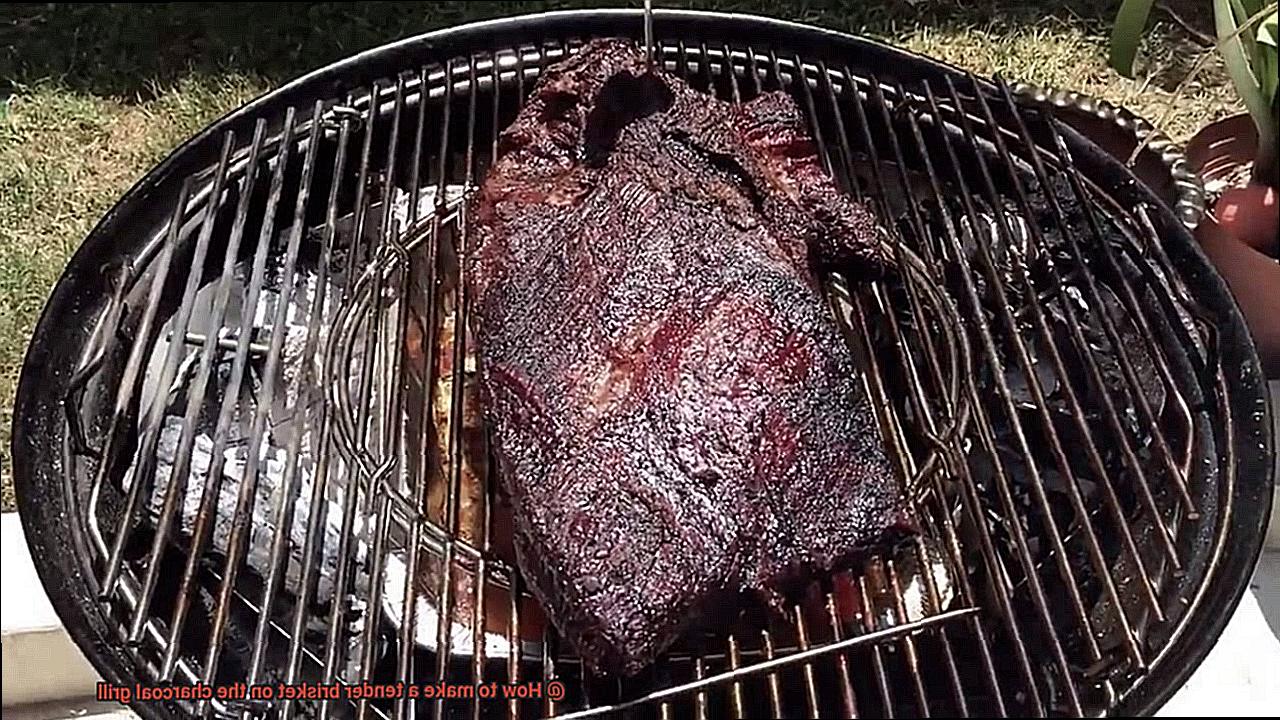
Setting Up a Two-Zone Fire
Look no further than the two-zone fire technique on your charcoal grill. This technique involves creating two distinct heat zones on the grill: a direct heat zone and an indirect heat zone.
To set up a two-zone fire, start by arranging unlit coals on one side of the grill. Then light a chimney starter full of charcoal until the coals are ashed over. Once ashed over, pour the hot coals onto one side of the grill, directly next to the unlit coals. This creates a hot direct heat zone on one side of the grill and a cooler indirect heat zone on the other side.
It’s important to note that you should always place your brisket on the indirect heat zone to avoid burning it. This way, you can cook it low and slow until it reaches its desired internal temperature. Adding wood chips or chunks to the hot coals will give your brisket that delicious smoky flavor that everyone loves.
Throughout the cooking process, keep an eye on your grill’s temperature and adjust the vents accordingly to maintain a steady temperature. Don’t forget to flip your brisket regularly for even cooking.
Here are some additional tips to ensure that your brisket is nothing short of perfection:
- Start with high-quality meat from a reputable butcher or supplier.
- Let your brisket come to room temperature before placing it on the grill.
- Season your brisket generously with your favorite dry rub or marinade.
- Use a meat thermometer to monitor your brisket’s internal temperature. For a tender brisket, aim for an internal temperature between 195-205°F.
- Let your brisket rest for at least 30 minutes after removing it from the grill to allow the juices to redistribute.
Seasoning the Brisket
The key to making a mouthwatering brisket on the charcoal grill lies in the art of seasoning. As an expert in all things BBQ, I’m excited to share with you different methods of seasoning a brisket and how each one can affect the flavor and tenderness of the meat.
Let’s start with dry rubs. This classic seasoning option is perfect for those who crave a bold and intense flavor. A dry rub is a heavenly mixture of spices and herbs that are generously rubbed onto the surface of the brisket. Customize your dry rub by using ingredients like salt, black pepper, garlic powder, onion powder, paprika, and chili powder. The key to a successful dry rub is to apply it evenly, allowing it to penetrate every inch of the meat. Let it sit for at least an hour before cooking to fully develop its flavors and make your taste buds sing.
If you want to take your brisket on a flavorful journey, marinades are a great option. Marinades typically consist of acidic ingredients like vinegar or citrus juice mixed with herbs and spices. Not only do they add flavor, but they also tenderize the meat. Marinate your brisket for at least a few hours or overnight to allow the flavors to seep deep into the meat. However, be cautious not to over-marinate as too much acid can toughen the meat.
Last but not least, injections can take your seasoning game up a notch. Injecting a liquid seasoning directly into the meat using a syringe allows the seasoning to reach deep into the muscle fibers. This method is especially helpful for large cuts of meat like brisket. A popular injection recipe includes beef broth, Worcestershire sauce, and soy sauce which gives the brisket an explosion of flavor.
No matter which seasoning method you choose, letting your brisket sit with the seasoning for at least an hour before placing it on the charcoal grill is crucial. This allows the flavors to fully develop and enhance the tenderness of the meat.
Searing the Brisket Over High Heat
Look no further than searing your brisket over high heat. This essential step is key when it comes to making a tender, flavorful brisket on the charcoal grill.
Why is searing so important? It helps lock in all those delicious flavors and juices, giving your brisket that extra boost of taste. Plus, it creates a beautiful crust that adds a satisfying crunch to each bite.
To achieve the perfect sear, start by ensuring your brisket is dry. Use paper towels to remove any excess moisture, then season it with your favorite dry rub or marinade. Once your grill has reached a temperature of around 450°F, place your brisket directly over the flames and sear each side for about 3-4 minutes.
But don’t get too caught up in the searing process – it’s important to keep a watchful eye on your brisket to avoid burning it. Be prepared to adjust the temperature of your grill or move the brisket around as needed for even searing.
Once both sides are seared to perfection, move your brisket to a cooler part of the grill and continue cooking it using indirect heat. This slow and steady method will result in a tender and juicy masterpiece.
Moving the Brisket to the Cooler Side of the Grill
To make a tender, juicy brisket that will have everyone raving, you need to master the technique of moving your brisket to the cooler side of the grill. This is a crucial step in achieving that perfect brisket.
To start, you need to create a two-zone fire. Light up your charcoal and let it burn for roughly 30 minutes until it forms gray ash. Spread the coals out on one side of the grill, leaving the other side empty. If you’re using a gas grill, turn off one or more burners on one side and leave only one or two lit burners on the searing side.
After achieving the perfect sear on your brisket over direct heat, it’s time to move it to the cooler side of the grill. This is where the real magic happens. The lower temperature ensures that your meat cooks through but stays moist and tender. Place your brisket away from direct heat and cover it with a lid.
This is when patience comes into play; your brisket needs to cook slowly at a temperature between 225-250°F. Don’t give in to temptation and lift the lid too often as this can cause temperature fluctuations and affect cooking time. Instead, use a reliable meat thermometer to check for doneness.
Consistency is key when cooking brisket on the grill. Use your vents or burner knobs as needed to maintain a consistent temperature throughout the cooking process. You may also need to add more charcoal or wood chips to keep the fire going.
Remember that your end goal is an internal temperature of around 195°F for a perfectly cooked brisket that falls apart in your mouth. With these tips, you’ll be well on your way to becoming a brisket pro.
Maintaining Temperature During Cooking
One of the most important factors in achieving this is maintaining temperature during cooking. This can be particularly challenging when using a charcoal grill, but fear not – we have some expert tips to help you master this technique like a pro.
Firstly, invest in an accurate thermometer and place it on the grate where your brisket will be cooking. This will give you an accurate reading of the temperature in that specific area, helping you to adjust the heat accordingly.
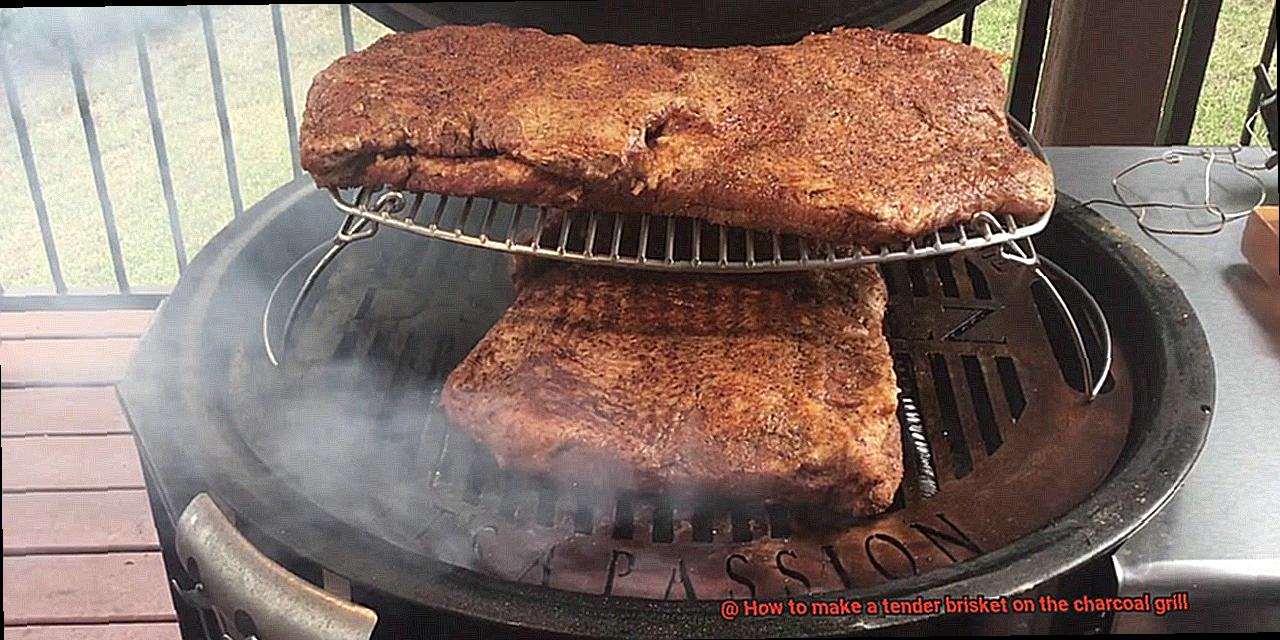
Next, set up your charcoal grill for indirect heat by placing the charcoal on one side of the grill and the brisket on the other. This prevents direct heat from drying out the meat and allows for more even cooking.
But how do you maintain a consistent temperature throughout the cooking process? The answer lies in adjusting the air vents on your grill. If the temperature is too high, close the vents slightly to reduce airflow and lower the temperature. If it’s too low, open them slightly to increase airflow and raise the temperature.
Another important factor is adding more charcoal as needed to maintain a consistent temperature. Keep an eye on your grill and add a few pieces of charcoal every hour or so, depending on how long your brisket will be cooking.
Finally, resist the temptation to peek too often. Keeping the lid on your grill as much as possible during cooking is essential to avoid sudden drops in temperature which can disrupt the cooking process.
Monitoring Internal Temperature of the Brisket
If you’re looking to impress your friends and family with a tender and flavorful brisket on your charcoal grill, then monitoring the internal temperature of your meat is crucial.
Brisket is a tough cut that needs to be cooked low and slow to break down the connective tissue, resulting in a melt-in-your-mouth texture. And to achieve that perfect texture, you’ll need a meat thermometer. There are two types to choose from: instant-read and leave-in. Instant-read thermometers are great for quick readings, while leave-in thermometers stay in the meat throughout the cooking process and can be monitored without opening the grill.
Once you’ve got your thermometer ready, it’s time to insert it into the thickest part of the brisket. Be sure to avoid any bones or fat pockets, as they can give you an inaccurate reading. The ideal internal temperature for a tender brisket is around 195-205°F (90-96°C). This temperature range ensures that the meat has been cooked long enough to break down the connective tissue and become tender.
But there’s more to it than just sticking a thermometer into your meat. Hot spots and cool spots on the grill can affect the cooking time and internal temperature of your brisket, so rotating it every hour or so is recommended. Additionally, placing it on a cooler part of the grill if it’s cooking too quickly will ensure even cooking and a consistent internal temperature throughout.
Don’t let the idea of monitoring internal temperature intimidate you – it’s truly the key to achieving a mouth-watering brisket on your charcoal grill. With the right tools and techniques, you can master this delicate dance between your grill and your brisket, sizzling up a storm with each juicy bite.
Resting and Slicing the Brisket
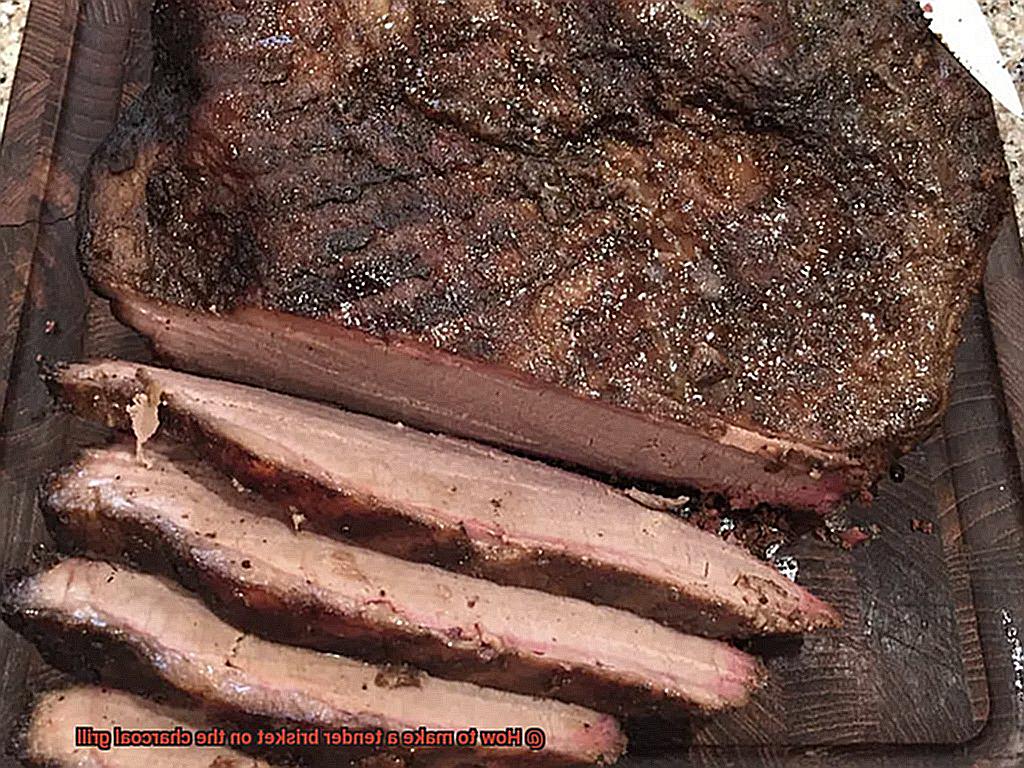
You’ve done it. You’ve cooked a brisket that’s sure to make your mouth water and your taste buds dance. But wait, the journey isn’t over yet. Resting and slicing the brisket is just as important as the cooking process itself. As an expert in this area, let me guide you through the final steps to ensure a mouthwatering and tender brisket.
Once your brisket has reached an internal temperature of 195°F – 205°F, remove it from the grill and give it at least 30 minutes to rest. During this resting period, something magical happens. The juices redistribute evenly throughout the meat, creating an explosion of flavor in every bite.
While your brisket is resting, keep it covered with foil or a towel to prevent it from drying out. And here’s a pro-tip: don’t cut into your brisket just yet. Patience is key here. Slicing too soon can cause all of those delicious juices to escape and leave you with a dry and tough piece of meat.
After your brisket has rested, take a moment to appreciate the beautiful marbling on its surface before slicing. When you’re ready to slice, make sure you cut against the grain of the meat. The grain can be identified by looking for lines running through the meat fibers. Cutting against these lines will result in shorter muscle fibers, making for a more tender and easy-to-chew brisket.
Now for the most important tool – your knife. A dull knife will tear rather than slice through the meat, causing it to lose its tenderness and become chewy. So, make sure you use a sharp knife when slicing your brisket.
Finally, let’s talk serving size. A standard portion of sliced brisket is around 4-6 ounces per person, but this can vary depending on personal preferences and whether or not other meats or sides are being served alongside the brisket.
4pEpuwdJOK4″ >
Conclusion
In the world of barbecue, few things are more satisfying than a perfectly cooked brisket. And when it comes to achieving that tender, mouthwatering masterpiece on the charcoal grill, there are a few key steps to keep in mind.
First and foremost, quality ingredients are paramount. Look for a well-marbled cut of meat with plenty of flavor potential. And don’t be afraid to get creative with your seasonings – whether you prefer dry rubs, marinades or injections, the right combination can take your brisket to the next level.
But it’s not just about what goes on top of the meat – it’s also about how you cook it. Using the two-zone fire technique on your charcoal grill allows for indirect heat and helps prevent overcooking or burning. Adding wood chips or chunks can infuse your brisket with that signature smoky flavor.
Throughout the cooking process, temperature control is crucial. Adjusting air vents and adding more charcoal as needed will help maintain consistency and ensure even cooking. And using a reliable thermometer to monitor internal temperature is essential for achieving that perfect texture.
When it’s time to slice and serve, remember to let your brisket rest for at least 30 minutes before cutting against the grain with a sharp knife. This final step ensures maximum tenderness and juiciness.
With these tips and tricks in your arsenal, you’ll be well-equipped to impress even the most discerning barbecue aficionados at your next backyard gathering.

